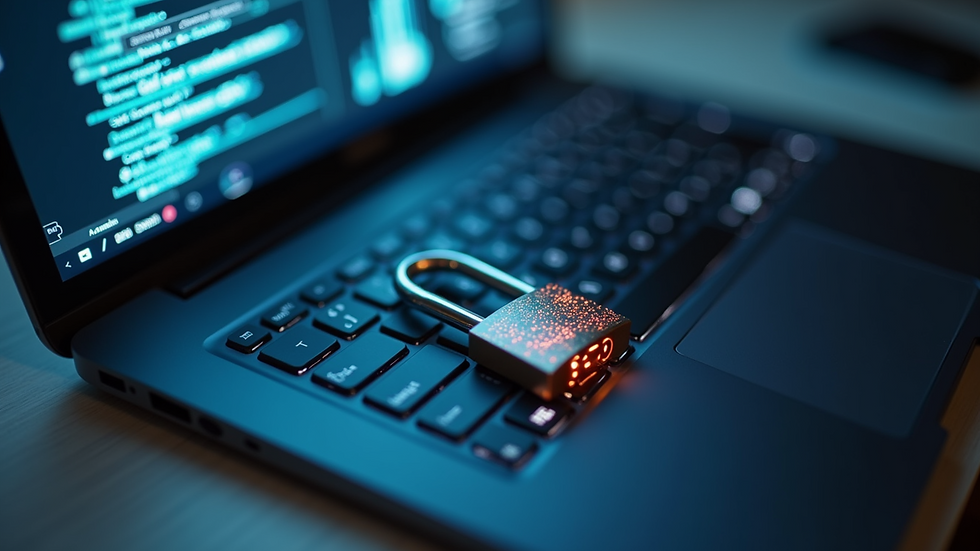Ransomware in 2025: Essential Insights for Small Business Owners on Prevention and Response
- Benji

- Feb 13
- 3 min read
Ransomware is becoming a major threat to businesses everywhere, and small and medium-sized businesses (SMBs) are especially at risk. With the rise of remote work and the increasing sophistication of cybercriminals, understanding how to defend against these attacks is essential for business owners as we approach 2025. This blog will discuss upcoming ransomware trends, the potential impact on SMBs, and practical strategies for prevention and response.
The Evolving Threat Landscape
As technology evolves, so do the tactics used by cybercriminals. In 2025, we can expect ransomware attacks to be more advanced. For example, research suggests that as many as 70% of ransomware attacks could leverage artificial intelligence, making them faster and more precise. This advancement means that even those without technical skills can potentially launch successful attacks through ransomware-as-a-service (RaaS) platforms.
The shift to remote work has widened the vulnerabilities for SMBs. A 2023 study found that 58% of remote workers admit to using personal devices for work, often without proper security measures. Cybercriminals are likely to exploit weaker security practices when targeting SMBs, which may not have the resources to enforce strict cybersecurity protocols.
The Financial Impact of Ransomware
The financial consequences of a ransomware attack can be staggering. According to a 2022 survey by Cybersecurity Ventures, the average cost of a ransomware incident for small businesses has reached nearly $150,000, taking into account ransom payments, recovery efforts, and lost income. This financial burden can be the tipping point for many SMBs, leading to financial distress or even closure.
Additionally, the reputational damage caused by a ransomware attack can remain long after the incident. Studies show that 60% of customers would reconsider doing business with a company that suffered a data breach. This loss of client trust can translate into significant revenue drops and a damaged brand image.
Key Prevention Strategies
Regular Backups
One of the best defenses against ransomware is maintaining regular backups of critical data. Backups should be stored offline or in a secure cloud, making them unreachable by ransomware. According to industry analysts, companies that regularly back up data see a 50% faster recovery time from an attack compared to those that do not. Having up-to-date backups can significantly lessen the impact of an attack.
Employee Training
Human mistakes often lead to successful ransomware breaches. Regular training helps employees identify phishing scams and other malicious activities. A 2023 report revealed that companies with ongoing cybersecurity training significantly reduced successful attacks by about 30%. Well-informed employees can be the first line of defense in guarding against cyber threats.
Implementing Strong Security Measures
Investing in robust cybersecurity tools is vital. This includes using firewalls, antivirus software, and intrusion detection systems. Additionally, ensuring that software is updated regularly can help close vulnerabilities that criminals may exploit. In fact, businesses that update their systems and use comprehensive security solutions report 40% fewer security breaches compared to those that do not.
Multi-Factor Authentication (MFA)
Adding an extra layer of security through multi-factor authentication can help protect sensitive accounts. Even if a password is compromised, MFA can stop unauthorized access. Statistics show that implementing MFA can reduce account takeover attacks by up to 99.9%.

Response Planning
Having a response plan is crucial, as no security measure is infallible. This plan should clearly outline the steps to take if a ransomware attack occurs:
Incident Response Team
Building an incident response team can streamline your approach to cyber incidents. Key roles should include IT, legal, and communication personnel to ensure all aspects are covered.
Communication Strategy
Communication is vital during a crisis. Businesses should prepare a plan for informing employees, customers, and stakeholders about the attack. Open communication can maintain trust and help mitigate reputational damage.
Engaging Cybersecurity Experts
If an attack occurs, having cybersecurity experts on hand can be invaluable. They can assist in assessing the threat, containing the situation, and guiding recovery efforts.
The Role of Cyber Insurance
As ransomware incidents increase, many SMBs are considering cyber insurance to reduce financial risk. A well-chosen policy can help cover ransom payments, recovery costs, and legal fees. However, it is crucial to carefully examine policy details to ensure the coverage meets your business's specific needs.
Looking Ahead
As we approach 2025, the threat of ransomware will continue to evolve, presenting ongoing challenges for small business owners. By recognizing potential risks and implementing effective prevention and response measures, SMBs can improve their protection against this growing threat. Regular backups, employee training, strong security systems, and well-defined response plans are crucial components of a solid cybersecurity strategy.
In an increasingly digital environment, staying informed and proactive is essential. By prioritizing cybersecurity, small business owners can protect their operations and foster long-term success.



Comments